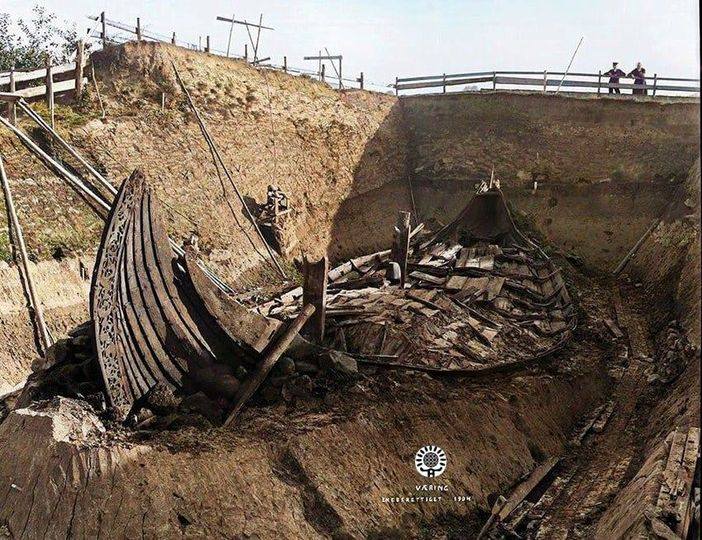The Oseberg Viking Ship, dated to 834 AD and unearthed from a burial mound near Tønsberg, Norway, stands as one of the most significant archaeological discoveries in history. This extraordinary vessel, measuring approximately 21.5 meters (70 feet) in length, is believed to have been used to honor two prominent women—one thought to be a queen and the other her servant—emphasizing the elevated role of women in Viking society. Its discovery has provided invaluable insights into Viking culture, shipbuilding expertise, and funerary traditions.

The craftsmanship and design of the Oseberg ship are truly remarkable, showcasing the Vikings’ advanced engineering and artistic capabilities. Built using oak and the clinker-style technique, the ship exemplifies the Vikings’ unparalleled shipbuilding skills. Its construction involved overlapping wooden planks fastened together with iron rivets, ensuring durability and flexibility—key traits for traversing the rough seas of the North Atlantic. Beyond its structural ingenuity, the Oseberg ship also highlights the Vikings’ artistic flair. Adorned with intricate carvings, including an exquisitely designed dragon head on its prow, the ship symbolizes protection and strength. These carvings were not merely decorative; they carried deep symbolic meanings that aligned with Viking beliefs and rituals, reinforcing the ship’s sacred role in funerary practices.
The burial mound where the Oseberg ship was discovered contained a wealth of grave goods, providing a window into the social structure and daily life of the Viking Age. Among the artifacts were textiles, tools, sleds, a cart, and even animal remains, all meticulously arranged within the ship. These items underscore the high social status of the individuals interred and offer a glimpse into the craftsmanship and resources available during that period. For example, the presence of ornately woven textiles suggests advanced weaving techniques, while the inclusion of everyday tools and transportation devices points to the practicalities of Viking life. Furthermore, the animal remains—including horses and oxen—highlight the significance of these creatures in Viking culture, both in life and in their beliefs about the afterlife.
The ship and its grave goods also provide critical insights into Viking funerary practices. The burial site’s elaborate arrangement reflects the Vikings’ belief in an afterlife and the continuation of life beyond death. The inclusion of a fully equipped ship as a burial vessel symbolizes a journey to the afterlife, suggesting a maritime culture deeply connected to spiritual and mythological themes. Excavated in 1904 by a team led by Gabriel Gustafson, the Oseberg burial site highlighted the importance of ships in Viking funerals. These burials were not merely acts of reverence but also a means to demonstrate the deceased’s societal status, wealth, and accomplishments. The excavation revealed the meticulous care the Vikings invested in preparing their dead for the next life, showcasing a belief system that combined spiritual reverence with cultural pride.
Today, the Oseberg Viking Ship is preserved in the Vikingskipshuset, or Viking Ship Museum, in Oslo, Norway. Its presence continues to captivate visitors and scholars alike, serving as a tangible link to a bygone era. The ship’s preservation has allowed researchers to study the intricacies of Viking shipbuilding, offering insights into their maritime technologies and innovations. For instance, the clinker-style construction not only provided the ship with exceptional seaworthiness but also influenced shipbuilding techniques in subsequent centuries. Additionally, the detailed carvings and craftsmanship have inspired studies into Viking art, revealing a culture that valued both functionality and beauty.
The legacy of the Oseberg ship extends beyond its physical structure. It stands as a testament to the Vikings’ ingenuity, their cultural richness, and their deep connection to the sea. This vessel is more than just an artifact; it is a symbol of a society that thrived on exploration, innovation, and resilience. By preserving the ship and its associated artifacts, historians and archaeologists have been able to piece together a vivid picture of Viking life, from their technological advancements to their societal values. The ship’s enduring presence in the Viking Ship Museum ensures that future generations can continue to learn from and be inspired by this remarkable piece of history.
The Oseberg Viking Ship also underscores the significant role of women in Viking society, a fact often overshadowed by the more widely known narratives of Viking warriors and explorers. The burial of two women with such an elaborate array of grave goods indicates their importance within the community. Whether one of them was a queen, a religious figure, or a person of great influence, the discovery challenges traditional assumptions about gender roles during the Viking Age. It suggests that women held positions of power and were deeply respected, playing vital roles in shaping Viking culture and society.
In conclusion, the Oseberg Viking Ship remains one of archaeology’s most valuable discoveries, providing unparalleled insights into the Viking world. From its advanced shipbuilding techniques to its intricate artistry, the ship embodies the ingenuity and cultural depth of the Vikings. Its role as a funerary vessel highlights the spiritual and societal values of the time, emphasizing the importance of the afterlife in Viking beliefs. Preserved in Oslo’s Viking Ship Museum, the Oseberg ship continues to educate and inspire, offering a glimpse into a fascinating past. As a symbol of the Vikings’ maritime heritage, artistic achievements, and societal structure, the Oseberg Viking Ship stands as a testament to the enduring legacy of one of history’s most intriguing civilizations.





